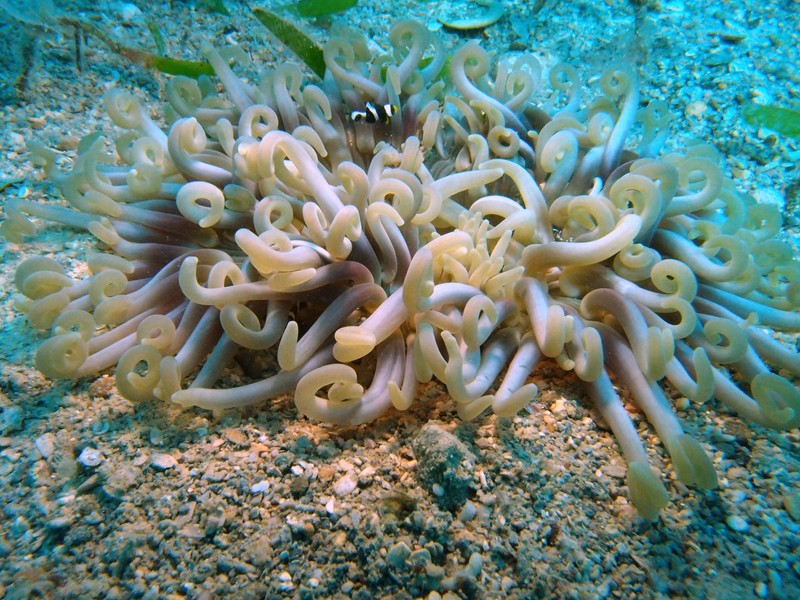MACRODACTYLA DOREENSIS - (QUOY & GAIMARD, 1833)
Cnidaria (Phylum) > Anthozoa (Class) > Hexacorallia (Subclass) > Actiniaria (Order) > Enthemonae (Suborder) > Actinioidea (Superfamily) > Actiniidae (Family) > Macrodactyla (Genus)
Anémone de mer tire-bouchon, Long Tentacle Anemone, Corkscrew Anemone, Sand Anemone, Red Base Anemone,
Anémone de mer tire-bouchon, Long Tentacle Anemone, Corkscrew Anemone, Sand Anemone, Red Base Anemone,
Synonymes
Actinia doreensis (Quoy & Gaimard, 1833)
Antheopsis doreensis (Quoy & Gaimard, 1833)
Anthopleura gelam (Haddon & Shackleton, 1893)
Cereactis doreyensis (Quoy & Gaimard, 1833)
Condylactis gelam (Haddon & Shackleton, 1893
Macrodactyla doorensis (Quoy & Gaimard, 1833)
Macrodactyla doreenensis (Quoy & Gaimard, 1833)
Macrodactyla gelam (Haddon & Shackleton, 1893)
Paractis doreyensis (Quoy & Gaimard, 1833)
Actinia doreensis (Quoy & Gaimard, 1833)
Antheopsis doreensis (Quoy & Gaimard, 1833)
Anthopleura gelam (Haddon & Shackleton, 1893)
Cereactis doreyensis (Quoy & Gaimard, 1833)
Condylactis gelam (Haddon & Shackleton, 1893
Macrodactyla doorensis (Quoy & Gaimard, 1833)
Macrodactyla doreenensis (Quoy & Gaimard, 1833)
Macrodactyla gelam (Haddon & Shackleton, 1893)
Paractis doreyensis (Quoy & Gaimard, 1833)
---------------------------------------------
Description
Macrodactyla doreensis has relatively few tentacles. They are all similar to one another in size and colour, being purplish-gray to brown. Each grows to about 1.75 cm, are sinuous, and each taper evenly toward the tip. In some cases they have a corkscrew shape. The oral disc is normally purplish-gray to brown, and sometimes has a green cast. It has a flared shape, and grows to a maximum of 5 cm wide, but is often far smaller. It has white lines that are oriented radially, sometimes extending onto the tentacles. This anemone remains at the surface of the sediment, with the column buried. The lower portion of the column is a dull orange to bright red colour, with the upper portion being brownish, containing a round to ovoid verrucae in rows oriented longitudinally.
Macrodactyla doreensis has relatively few tentacles. They are all similar to one another in size and colour, being purplish-gray to brown. Each grows to about 1.75 cm, are sinuous, and each taper evenly toward the tip. In some cases they have a corkscrew shape. The oral disc is normally purplish-gray to brown, and sometimes has a green cast. It has a flared shape, and grows to a maximum of 5 cm wide, but is often far smaller. It has white lines that are oriented radially, sometimes extending onto the tentacles. This anemone remains at the surface of the sediment, with the column buried. The lower portion of the column is a dull orange to bright red colour, with the upper portion being brownish, containing a round to ovoid verrucae in rows oriented longitudinally.
Distribution
This species is found in Japan, and south to the waters of New Guinea, northern Australia, and New Caledonia.
This species is found in Japan, and south to the waters of New Guinea, northern Australia, and New Caledonia.
Biology
This species is commonly found at depths of 5 metres or less in muddy bottoms, and is commonly seen without fish present.
The tentacles of Macrodactyla doreensis may either shrivel, or stick to hand of a person who disturbs it. This anemone can retract entirely into the sediment.
This species is commonly found at depths of 5 metres or less in muddy bottoms, and is commonly seen without fish present.
The tentacles of Macrodactyla doreensis may either shrivel, or stick to hand of a person who disturbs it. This anemone can retract entirely into the sediment.
Macrodactyla doreensis is a host of five different species of fish
